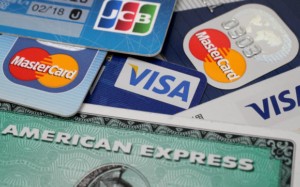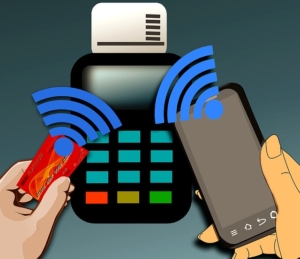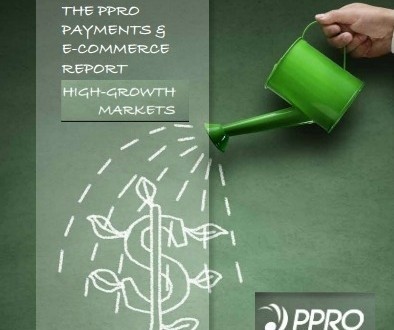 London headquartered PPRO Financial Ltd recently published a report profiling the payments methods in the world’s fastest-growing e-commerce economies. The PPRO Payments and E-commerce Report: High Growth Markets is a fascinating look at countries on fast-track e-commerce growth and they’re almost entirely in developing countries. PaymentsNEXT has highlights of this report.
London headquartered PPRO Financial Ltd recently published a report profiling the payments methods in the world’s fastest-growing e-commerce economies. The PPRO Payments and E-commerce Report: High Growth Markets is a fascinating look at countries on fast-track e-commerce growth and they’re almost entirely in developing countries. PaymentsNEXT has highlights of this report.
11 fastest growing e-commerce economies
The list of fastest growing e-commerce economies had some interesting surprises – nearly all were developing countries with annual growth rates that modern countries can only envy: China (63.8%), Malaysia (47%), Indonesia (45%), Saudi Arabia (43%), Russia (42%), Argentina (38%), Vietnam (37%), Mexico (30%), Israel (25%), Singapore (25%) and Hungary (25%).
Annual value of e-commerce (USD)
The annual value of e-commerce in these fast-growing economies varied widely but provided some interesting potential opportunities for businesses willing to invest. The value of e-commerce in China totals more than the US and UK combined. Mexico’s e-commerce of 5.7 billion dollars is substantial but with a population of 117 million, growth is just a matter of time and technology.
 China $538 billion
China $538 billion
Mexico $5.7 billion
Argentina $4.5 billion
Singapore $2.5 billion
Indonesia $2.4 billion
Israel $2.1 billion
Saudi Arabia $2.0 billion
Russia $2.0 billion
Vietnam $1.5 billion
Hungary $1.0 billion
Malaysia $700 million
While many of these values look small, remember that some countries such as Israel, Saudi Arabia, and Singapore have relatively small populations.
Average annual spending online (USD)
Not surprisingly, the average online annual e-commerce spending in these high-growth economies reflects the strength of the economy and stage of development of countries:
Israel ($2,171), Singapore ($1,861), China ($1,703), Russia ($865), Mexico ($864), Saudi Arabia ($714), Argentina ($462), Malaysia ($412), Hungary ($391), Indonesia ($256) and Vietnam ($145).
How “banked” are these economies?
The number of people with bank accounts varies widely in these countries. At the lower end of populations with bank accounts are Vietnam (21%), Argentina (27%), Indonesia (36%) and Mexico (39%). In these countries, goods are often paid for by cash on delivery.
Most of the other countries are better developed when it comes to banking and financial services: Argentina (50%),Russia (67%), Saudi Arabia (69%), Hungary (72%), China (79%), Malaysia (81%), Israel (90%) and Singapore (96%).
Credit card penetration & payment preferences
 Credit card penetration is an interesting indicator of potential for e-commerce. Most of these developing countries have an expected and extremely low rate of credit card access and usage: Vietnam (2%), Indonesia (2%), Hungary (12%), Saudi Arabia (12%), China (16%), Mexico (18%), Malaysia (20%), Russia (21%), Argentina (27%), Singapore (35%) and Israel (76%).
Credit card penetration is an interesting indicator of potential for e-commerce. Most of these developing countries have an expected and extremely low rate of credit card access and usage: Vietnam (2%), Indonesia (2%), Hungary (12%), Saudi Arabia (12%), China (16%), Mexico (18%), Malaysia (20%), Russia (21%), Argentina (27%), Singapore (35%) and Israel (76%).
The challenge as Amazon and other global companies have found is to encourage new ways to pay for e-commerce products in these fast-growing e-commerce economies. That’s why alternative payments such as bank transfers, e-wallets, mobile payment apps and other fintech solutions are taking hold in Africa and developing countries with large “unbanked” populations around the world.
In Hungary, for example, 60% of e-commerce purchases are paid for by cash. E-commerce companies generate a code which consumers take to a nearby bricks and mortar outlet and pay for their purchase with a small fee added. The e-commerce companies then ship on notice of payment.
Mexicans pay with cards 32% of the time, 28% by credit cards and 18% with e-wallets. In Vietnam, 64% of purchases are by cash with 13% by e-wallet while in Argentina, 44% of purchases are made with cards and 44% by cash.
53% of Russians pay by cash, 17% by payment cards and 13% with e-wallets. In Saudi Arabia, 59% of consumers pay by cash using coupons generated by e-commerce companies who then deliver the product after payment notification; 26% pay with cards and 10% by e-wallets.
In Indonesia, 39% of consumers pay by bank transfers, 29% by payment cards, followed by 25% by cash payments. Malaysians pay with bank transfers 40% of the time, 39% with payment cards and 18% with cash
By contrast, in Singapore the most popular payments are by cards and increasingly by e-wallets. PayPal and MasterPass are the most common e-wallets. Israel also has a high level of card payments (84%) and e-wallets (14%).
Internet access
 In some countries internet access is a challenge due to infrastructure. But many countries have simply leaped ahead of technology infrastructure and gone mobile-first. As China has shown, this presents unique competitive challenges for the fully developed countries which must still migrate from older technology and infrastructure to mobile.
In some countries internet access is a challenge due to infrastructure. But many countries have simply leaped ahead of technology infrastructure and gone mobile-first. As China has shown, this presents unique competitive challenges for the fully developed countries which must still migrate from older technology and infrastructure to mobile.
Countries with the lowest internet access include: Indonesia (31%), Vietnam (36%), Mexico (44%) and China (51%).
Other fast-growing economies have better internet access including: Saudi Arabia (64%), Argentina (65%), Malaysia (68%), Russia (71%), Israel (72%), Hungary (75%) and Singapore (82%).
Smartphone adoption
The use of mobile phones is widespread in place of other infrastructure.
 The lack of infrastructure is both a problem and an opportunity. Mobile technology presents opportunities for development of mobile payments apps and other Innovations that are not even available in the more modern economies. In China, Alibaba and Tencent already do the majority of their business through mobile sales.
The lack of infrastructure is both a problem and an opportunity. Mobile technology presents opportunities for development of mobile payments apps and other Innovations that are not even available in the more modern economies. In China, Alibaba and Tencent already do the majority of their business through mobile sales.
Smartphone penetration includes Israel (93%), Singapore (82%), Saudi Arabia (73%), China (51%), Hungary (50%), Mexico (47%), Russia (45%), Argentina (44%), Vietnam (42%), Malaysia (41%) and Indonesia (37%).
Other report insights
The data in this report also provides a number of other insights for companies considering expanding into these supercharged e-commerce economies. Payments and logistics are the crucial ingredients to success.
In those markets where credit cards are not prevalent, online payments and alternate payments solutions such as payment on delivery, must be considered carefully for bottom-line impact. In Mexico for example, Amazon and Alibaba are investing in package delivery and other logistics solutions.
All in all, PPRO’s report offers valuable insight into e-commerce and payments in these booming e-commerce economies.
Free report available
PPRO Financial ‘s report is available for free here.

